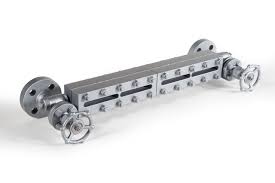Reflex Level Gauges




Reflex Level Gauges
Reflex Level Gauges are indispensable instruments used for visual liquid level indication in various industrial applications. They offer a reliable and efficient method for monitoring liquid levels in tanks, vessels, and pipelines, ensuring safe and efficient operation of processes.
Key Features:
Prismatic Grooves: Reflex level gauges are equipped with prismatic grooves on one side of the viewing area. These grooves capture and refract light differently depending on the liquid level, creating a distinct contrast between the liquid and vapor phases.
High Visibility: The prismatic grooves in reflex gauges ensure high visibility of liquid levels, even in environments with poor lighting conditions or under high-pressure conditions. This makes them suitable for applications where clear level indication is essential.
Durable Construction: Constructed from robust materials such as borosilicate glass or toughened plastics, reflex level gauges offer excellent resistance to corrosion, high temperatures, and mechanical stress, ensuring long-term reliability in harsh industrial environments.
Bi-Color Indicator: Reflex gauges typically feature a bi-color indicator, with one color representing the liquid phase and the other color representing the vapor phase. This allows operators to easily differentiate between the two phases and accurately determine the liquid level.
Easy Installation and Maintenance: Reflex level gauges are designed for easy installation and maintenance, with standard mounting configurations and simple cleaning procedures. This minimizes downtime and ensures continuous operation of the level measurement system.
Applications:
Steam Boilers: Used in steam boilers to monitor water levels and prevent dry firing or overfilling, ensuring safe and efficient steam generation.
Pressure Vessels: Installed on pressure vessels and storage tanks in various industries to provide visual indication of liquid levels, enabling precise control of processes and preventing spills or leaks.
Chemical Processing: Integrated into pipelines and equipment in chemical processing plants to monitor levels of corrosive or hazardous liquids, ensuring safe handling and operation.
Petrochemical Industry: Utilized in refineries and petrochemical plants to monitor levels of hydrocarbons, gases, and liquids in storage tanks and processing equipment, preventing overflows and underfills.